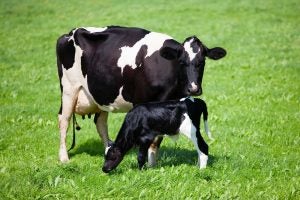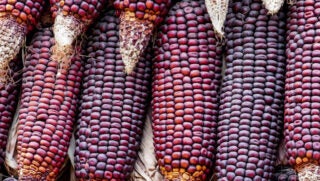Many people unfamiliar with agriculture have asked: Is artificial insemination of dairy cows abuse? The short answer is no. Artificial insemination is a safe and humane procedure that farmers use to improve livestock safety, health, and genetics.
Artificial insemination (often referred to in the ag industry as A.I.) is the process of depositing sperm cells in the female reproductive tract via instrumental means for the purpose of breeding. It’s a procedure that is done by trained technicians, or even farmers themselves who have gone through training and certification. And one interesting fact is that it’s a reproductive technology also used in humans!
@iowadairyfarmer Artificial insemination is safer for the cows and for the farmer and results in the cow achieving its biological goal – getting pregnant.
A brief history of artificial insemination
Artificial insemination is not a new technology. In the 17th century, Dutch scientist Antonie van Leeuwenhoek was the first to observe and describe sperm cells in semen. A century later, an Italian priest and physiologist named Lazzaro Spallanzani performed the first known artificial insemination in a dog, which resulted in three pups. Artificial insemination became a focal point of study in the early 20th century, starting in Russia and Japan before spreading to Denmark and the rest of the west.
The 1940s saw huge growth and innovation of artificial insemination in U.S. dairy cattle, which influenced growth across the world. Further innovation in semen preservation, quality, and collection methods continued over the 20th century. Genetic selection in dairy cattle also improved. Both reproduction and genetics continue to be a huge area of research and innovation.
When are cows bred?
Farmers only breed their animals when they’re fertile. For a cow, every 21 days they have a fertile period, called estrus — or being “in heat.” A cow can only get pregnant during this window, so there’s no reason for them to be bred if they’re not in heat.
They signal they’re in heat by increased vocalization, increased locomotion, twitching and elevating the tail, increased grooming and licking, mounting other animals, and standing to be mounted. The most definitive sign is standing to be mounted by another cow. If there is a bull, this would signal him to breed the cow. Without a bull, this is how farmers would know the cow is ready to be bred.

Are dairy cows being bred constantly?
Farmers choose to not breed their cows every single time they’re in heat. A cow may come in heat within a couple weeks of calving, but that’s not the best time for their health to breed them. Farmers wait to breed their cows typically in 50 to 80 days since they gave birth, called a voluntary waiting period. Farmers customize this based on what works best with their herd. Periodic health checks from veterinarians also ensure a cow is ready to be bred.
Heifers, young female bovines who have not given birth, are not being constantly bred either. Farmers wait until the heifer is big enough both in frame and weight and old enough to safely carry a pregnancy and have no problems giving birth.
Couldn’t farmers just use a bull?
Some farms choose to use bulls, but many dairy farms have switched to artificial insemination. To a cow in heat, they’re goal is to get pregnant. Whether via bull or artificial insemination, it doesn’t make a difference to them.
One of the biggest advantages to artificial insemination is safety. Bulls — especially dairy bulls — can be large and aggressive. It’s a well-known adage to never turn your back on a bull, as even the seemingly nice ones can turn on you. It’s also safer for the cows. Bulls are on a mission to breed whatever cow is in heat, even if the cow has only recently calved, is too small, or is related. Artificial insemination also significantly decreases the risk of venereal diseases.
Another big advantage is genetics. Innovations in semen preservation have allowed semen to be shipped from bulls from around the country and world. When using bulls for breeding, it’s difficult to match the variation and selection of artificial insemination. A farm may run a bull or two, versus having semen samples stored from dozens of bulls from across the world to choose from. With more bulls to choose from, genetic selection can be used to further improve the herd. Whether that be through calving-ease bulls, bulls with high health traits, good-feet-and-leg bulls, or ones that make daughters that produce more milk or milk solids.
Farmers may still choose to use bulls. However, they make sure to use correctly sized bulls and manage them appropriately to minimize the above risks.
The bottom line is that artificial insemination is a safe and humane technology that has been used for a long time to improve the safety, genetics, and health of animals. It is not abuse.
Michelle Miller, the Farm Babe, is a farmer, public speaker and writer who has worked for years with row crops, beef cattle, and sheep. She believes education is key in bridging the gap between farmers and consumers.



